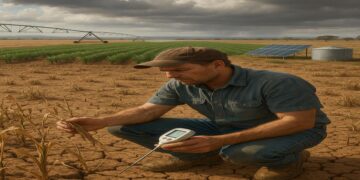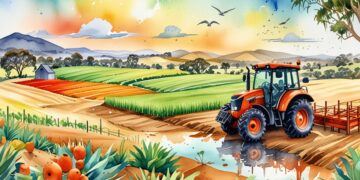Investing in Sustainable Agriculture: Opportunities and Challenges in the Australian Market

The Evolution of Sustainable Agriculture in Australia
The financial landscape is transforming, particularly in sectors like agriculture, which is embracing sustainability in exciting new ways. Sustainable agriculture offers immense potential, propelled by the increasing consumer demand for ethically sourced produce and the urgent need to address climate change challenges. Australia, known for its rich agricultural history, is at the forefront of this evolution, leveraging innovative technologies and practices to ensure a sustainable future.
Opportunities Ahead
A variety of factors are driving investors’ interest in sustainable agriculture within Australia, creating a dynamic and financially intriguing environment:
- Innovative agricultural technologies: Thanks to advancements like drones, artificial intelligence (AI), and precision farming techniques, crop management has never been more efficient. For instance, AI algorithms can analyze data collected from IoT sensors to optimize water usage and nutrient delivery, thereby enhancing yield while minimizing resource waste.
- Government incentives: The Australian government is keen on promoting green practices through various initiatives designed to boost profitability. Programs that offer subsidies or tax breaks for implementing sustainable practices can substantially lower the entry barriers for investors looking to make a positive impact.
- Market trends: The rise of awareness among consumers about the environmental footprint of their food choices has accelerated demand for organic and locally sourced products. Farmers who adapt to these market shifts can capture premium prices, making their operations not only sustainable but also highly lucrative.
Challenges to Consider
While the potential of sustainable agriculture is vast, it’s crucial for investors to acknowledge and navigate certain challenges:
- Market volatility: Agricultural markets can be highly unpredictable, with fluctuating commodity prices impacting profit margins. For example, droughts or floods can diminish supply, causing spiking prices that are difficult to project.
- Access to capital: Entering the sustainable agriculture sector often requires significant upfront investment, whether for advanced equipment or operational shifts. Identifying funding sources that are aligned with sustainability goals may prove challenging, yet collaborations between public and private sectors can provide viable solutions.
- Regulatory hurdles: Adhering to environmental regulations is vital yet can be complex and time-consuming. Understanding the compliance requirements and adopting best practices to meet them is essential for long-term success in sustainable ventures.
A Promising Future
The intersection of finance and agriculture is poised for innovation, and in Australia, the future of sustainable ventures is looking bright. By embracing new technologies and fostering sustainable practices, investors have the opportunity to not only secure financial returns but also contribute positively to the environment. The digital transformation of the financial sector is providing unique platforms for farmers and investors to collaborate, making it easier to target sustainable solutions that can propel the agricultural economy into a robust and resilient future.
Harnessing Digital Innovations in Sustainable Agriculture
As the Australian agricultural landscape evolves, the integration of digital technologies plays a pivotal role in enhancing sustainable practices. The intersection of finance and agriculture is transforming, as investors increasingly leverage data-driven solutions to optimize productivity and ensure environmental stewardship. This digital revolution is creating a new paradigm where farmers and investors can collaborate effectively, maximizing returns while addressing climate challenges.
Emerging Financial Trends Driving Investment
Several key financial trends are emerging within the realm of sustainable agriculture in Australia, each bolstered by cutting-edge technology:
- Blockchain technology</: Positioning itself as a game-changer, blockchain enables transparency and traceability in the supply chain. By utilizing this technology, producers can provide proof of sustainability claims, thus enhancing consumer trust and potentially commanding higher prices for their products.
- Digital marketplaces: Platforms that connect farmers directly with consumers or investors are proliferating. These innovative marketplaces facilitate seamless transactions and open doors for smallholders to access broader markets, allowing them to profit from their sustainable practices.
- Agri-tech funding platforms: Specialized fintech solutions designed to fund agricultural projects are gaining traction. These platforms streamline the funding process, making it easier for entrepreneurs and farmers implementing sustainable methods to secure the capital they need.
This synergy between finance and technological innovation not only fosters growth in the sustainable agriculture sector but also resonates with socially-conscious investors seeking to align their portfolios with their values. The willingness of investors to support agricultural practices that benefit both society and the planet is increasingly apparent, signaling a profound shift in investment priorities.
Real-World Applications of Technology
Investors in sustainable agriculture can look to various real-world applications borne out of technological advancements that are driving success:
- Remote sensing technology: Utilized for crop monitoring, this technology allows farmers to assess plant health and soil conditions in real-time, ensuring that inputs are applied precisely when and where they are needed, reducing waste and increasing yield.
- Vertical farming solutions: Urban areas in Australia are embracing vertical farming, where crops are grown in controlled environments, often indoors. This method conserves space, drastically reduces water usage, and minimizes transportation costs by operating closer to consumers.
- Farm management software: These digital tools allow farmers to efficiently manage resources, track productivity, and analyze data to make informed decisions that promote sustainability while optimizing operational efficiency.
As these examples illustrate, the adoption of technology-driven solutions is not just a trend but a necessity in equipping Australian agriculture to face future challenges. With nearly every step of agricultural processes becoming digitized, the opportunities for sustainable investment are expanding exponentially. The potential for creating a more resilient, environmentally friendly agricultural sector is immense, paving the way for a prosperous future where innovation meets sustainability.
The Role of Collaborations and Partnerships
The success of sustainable agriculture in Australia hinges not just on technological innovations but also on the strength of collaborations and partnerships across various sectors. These alliances are pivotal in enhancing resource sharing, knowledge transfer, and ultimately, investment efficiency. As the need for sustainable solutions intensifies, the collaborative spirit in the farming community is invigorating, drawing in a wide array of stakeholders, including universities, government bodies, and private investors.
Public-Private Partnerships (PPPs)
Public-private partnerships are becoming increasingly vital in addressing the financial barriers faced by sustainable agriculture initiatives. These collaborations leverage governmental support and resources, combined with private sector investment, to foster innovation and infrastructure development. For instance, projects that promote regenerative agriculture practices have witnessed significant backing from both government initiatives and impact investors who understand the long-term benefits of sustainable farming methodologies.
- Research and development collaborations: Institutions like the University of Sydney and the CSIRO are forging partnerships with agribusiness firms to drive research in sustainable farming practices. By pooling resources, they can develop cutting-edge technologies—such as drone-assisted planting or biocontrol methods—that can be quickly adopted by farmers.
- Government incentives: The Australian government is continually rolling out grant programs and subsidies aimed at promoting sustainable agriculture. Investors can tap into these schemes, providing essential funding that not only mitigates individual financial risks but also aligns with the government’s climate targets.
Community Engagement and Stakeholder Involvement
Successful sustainable agriculture also leans heavily on community engagement. Farmers are encouraged to connect with local communities to understand their needs and incorporate sustainable practices that resonate with consumers. This two-way relationship effectively marries investment with grassroots efforts, enhancing the marketability of sustainably produced goods.
- Consumer advocacy groups: These organizations are increasingly pushing for transparency in the food supply chain, advocating for products that are sustainably sourced. By aligning with these groups, investors can enhance their portfolio’s credibility while accessing a growing consumer base that prioritizes ethical consumption.
- Educational initiatives: Collaborative programs aimed at educating farmers and consumers alike about sustainability practices have become widespread. Programs led by various agricultural organizations empower farmers with the knowledge they need to adopt environmentally-friendly methods, leading to an overall enhancement in sustainable practices.
Financing Models for Sustainable Agriculture
Innovative financing models are essential for overcoming barriers to investment in sustainable agriculture. One such model gaining traction is the impact investing approach, where investors seek a measurable social and environmental impact alongside a financial return. This has encouraged a growing number of investors, including institutional funds, to direct their capital towards sustainable agricultural endeavors that promise to yield both profit and positive environmental outcomes.
Moreover, green bonds specifically designed for agriculture are emerging as a strong financial tool, allowing entities to raise capital earmarked for sustainability projects. These financial instruments invite a new wave of investors interested in supporting projects that promote biodiversity, carbon sequestration, and reduced water usage. As more entities adopt this model, the momentum towards a greener agricultural sector is both viable and promising.
Through dynamic partnerships, community involvement, and innovative financing mechanisms, the Australian market for sustainable agriculture is poised for growth. With every stakeholder bringing unique strengths to the table, the opportunities for enhancing sustainability become more significant, painting a positive picture for future investments.
Conclusion
As we navigate the evolving landscape of sustainable agriculture in Australia, the convergence of innovation, collaboration, and financing is paving the way for a transformative agricultural model. The opportunities for investors are vast, propelled by technological advancements that enhance efficiency and sustainability, paired with the growing consumer demand for ethically produced food. Emerging financing trends such as impact investing and green bonds are enabling a more diverse pool of stakeholders to participate in this exciting sector, aligning financial returns with positive environmental and social outcomes.
Challenges remain, particularly in ensuring equitable access to resources and information among smaller producers. However, the robust network of public-private partnerships, educational initiatives, and community engagement efforts is fostering resilience and opening pathways for more farmers to adopt sustainable practices. This collaborative approach not only enhances the potential for innovation but also builds trust with consumers who are eager to support sustainable products.
Looking ahead, Australia’s sustainable agriculture sector stands at the cusp of a digital transformation that promises to redefine not only farming methods but also investment strategies. By harnessing the power of new technologies like precision agriculture and blockchain, we can enhance transparency in the supply chain and foster a thriving ecosystem that benefits both investors and the environment. With the right commitment and resources, the future of sustainable agriculture in Australia is not just promising—it’s a tangible reality that we can all look forward to.

James Carter is a financial writer and advisor with expertise in economics, personal finance, and investment strategies. With years of experience helping individuals and businesses make complex financial decisions, James offers practical insight and analysis. His goal is to give readers the knowledge they need to achieve financial success.






